Welcome to Blue Book!
Are you ready to join the thousands of companies who rely on Blue Book to drive smarter decisions? View our plans and get started today!
Still have questions? We’d love to show you what Blue Book can do for you. Drop us a line– we’ve been waiting for you.

Of course, there’s domestic rivalry too—not only between U.S. grape growers but among other fruits as well. Corsaro-Dorsey acknowledges consumers may substitute other commodities for grapes, but finds the range of proprietary grape varieties gives shoppers plenty of choices. “It’s all about who has best [variety] in each time period.”
Olsen, too, sees rising competition within the industry having an effect on not only which varieties are planted, but how much acreage is devoted to each type.
New Kids on the Block
Giumarra Vineyards Corporation has been growing grapes for over 70 years. The grower recently began replacing acres of Thompson Seedless, Red Flames, and Red Globes with newer proprietary red and black varieties.
“We’re an old company, and had a lot of nonproprietary varieties like Thompsons, which are in the public domain,” explains Mimi Corsaro-Dorsey, Giumarra’s vice president of marketing and director of export sales. The new varieties, she reports, are popular with export markets which account for up to a third of the company’s annual shipments.
Passion Fire, also known as ARRA 29 (bred by ARD LLC, a division of Giumarra), is marketed as a substitute for Flame Seedless and gaining both domestic and international acceptance. Another, the ‘Sweetie,’ or ARRA 15, is a white or ‘buttery’ green seedless variety to replace Thompsons, and is currently in production in Chile and other countries. It has an impressive trait: rain resistance.
Mystic Dream, or ARRA 32, has also caught the eye of growers. The large, black seedless grape ripens very late in the season, making it a great addition to the export market. It is viewed as an improvement on the Autumn Royale variety, tasty but prone to shatter (the loss of its berries).
Many of the newer varieties are designed specifically for export and to fill supply gaps. “There’s more focus on that late window between California and Peru, where there’s a time gap,” explains Corsaro-Dorsey.
Cultivars that can hit the new variety trifecta will go into wider production: “The winners with the better flavor profile, more consumer likes, and better shelf life—all characteristics we look for in breeding programs—are going to emerge,” she notes. The next five years or so will present an interesting shuffle in the table grape industry, to see which varieties stick.
Weather & Labor Hurdles
By most any standard, California’s recent spate of trials and tribulations was remarkable. “Every year presents a fundamentally new challenge,” shares Vallis. In the last year, there was “drought, then a labor shortage, then lots of rain, then even less labor. We don’t get to look back at history to solve [problems], but have to make it up as we go,” he says.Corsaro-Dorsey, too, commented on the “strange weather” from “a rare hot spell, freak rain storms the last two years, then much more rain this year” and how it will affect the upcoming season’s grapes. “It looks like things are going to be a little early compared to last year—and last year was early,” she observes. When it comes to weather’s unpredictability, she says, “We expect the worst and pray for the best, but try to be prepared for anything that hits us.”








